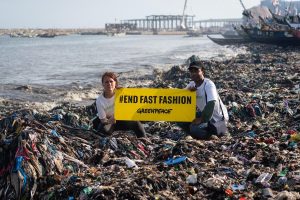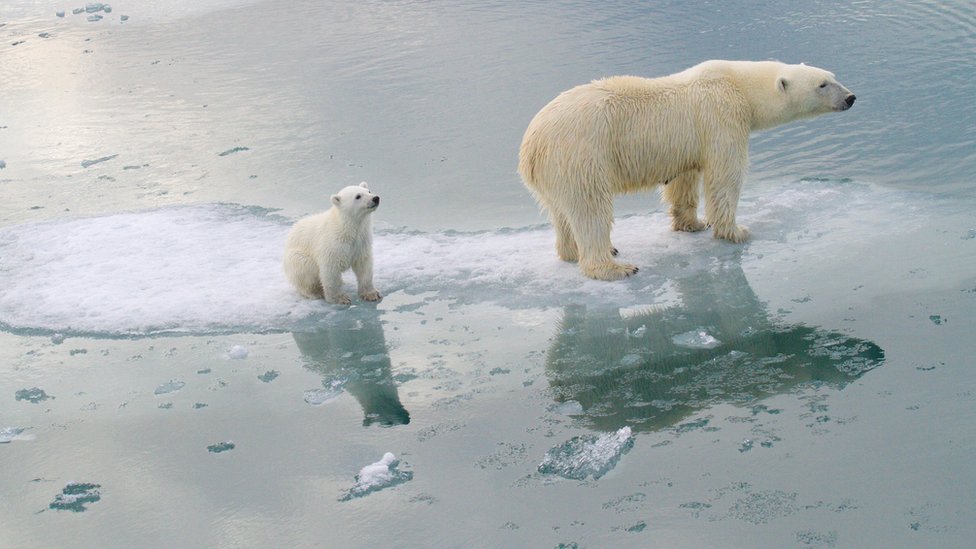After a long day of work, all you want to do is go home and lie in bed, hoping that the next day will be better than it is now. As you arrive home, you realize the floorboards and walls of your home are crumbling apart, the roof has collapsed in on itself, leaving you with nothing. No place to call your sanctuary. Nothing to protect you from the outside. This life is one that too many creatures are familiar with. For example, in the Arctic, most polar bears are often left defenseless and stranded in the ocean with nowhere to go but down. The leading cause of this heartbreak is climate change.
What is Fast Fashion?
Fast Fashion is an approach to the design, creation, and marketing of clothing fashions that emphasizes making fashion trends quickly and cheaply available to consumers. Fast Fashion relies heavily on trends or fads that keep people engaged with anything that these companies can mass-produce. Most consumers of this industry have reported that statistically, they wear fast fashion products less than ten times overall, sometimes even as few as three. Such companies that participate in the fast fashion industry are brands like Shein, Zara, H&M, Temu, Lululemon, Nike, Urban Outfitters, and many more. Shein is one of the most significant contributors to environmental damage. According to an article by Green America Magazine, on average, Shein pushes out at least 1,000 new clothing items daily. They are the fastest-growing fast fashion company, and not only does this heavily impact climate change, but the actual workplace and products themselves are toxic.
In another article written by Yale Climate Connections, Shein published a sustainability report in 2023, which revealed that they emitted 16.7 million tons of carbon dioxide that year alone. This is more than what four coal power plants could generate in one year. C02 emissions, while important, can be destructive in large quantities. Especially when combined with deforestation, there is nowhere for the excess carbon dioxide to go but to remain trapped in the atmosphere, resulting in continuously increasing temperatures on Earth.
How Global Warming Affects the Earth
Climate change refers to a long-term shift in the average weather patterns that have come to define Earth’s local, regional, and global climates. The rapid progression of climate change leaves many habitats and environments in ruin due to increased temperatures. Not only does this impact countless species, including humans, but it also affects the Earth’s overall sustainability. Sustainability is defined as the quality of causing minimal or no damage to the environment, thereby allowing it to continue for an extended period. Without sustainability, we are lost. But how does climate change even happen? Several factors contribute to the evolution of climate change, including deforestation, livestock farming, the burning of fossil fuels, and the fast fashion industry.
But Where Do the Clothes Go?
So, fast fashion negatively affects the animals and their habitats, but what about us? How does climate change directly affect humans? When people strictly follow fashion trends, it leads them to update their wardrobes  constantly with the latest styles. But then what do you do with all the ‘old’ clothing? The answer most conclude with is to throw it all out. While this action doesn’t seem unethical in itself, you have to consider the consequences of this. Where do the clothes go after they’re thrown out? They don’t just disappear into thin air; they get dumped and dumped into many people’s homes. This leaves many individuals, children included, being forced to live in unhealthy locations, having to walk across mountainous piles of used clothes, all for the sake of fast fashion. Society has led us to believe in the ‘out of sight, out of mind’ mentality. Meaning that since we can no longer see the items themselves, they must not exist anymore. The same cannot be said for those living in the Atacama Desert.
constantly with the latest styles. But then what do you do with all the ‘old’ clothing? The answer most conclude with is to throw it all out. While this action doesn’t seem unethical in itself, you have to consider the consequences of this. Where do the clothes go after they’re thrown out? They don’t just disappear into thin air; they get dumped and dumped into many people’s homes. This leaves many individuals, children included, being forced to live in unhealthy locations, having to walk across mountainous piles of used clothes, all for the sake of fast fashion. Society has led us to believe in the ‘out of sight, out of mind’ mentality. Meaning that since we can no longer see the items themselves, they must not exist anymore. The same cannot be said for those living in the Atacama Desert.
The Atacama Desert in Chile has become a clothing waste hotspot. Piles of clothes stacked miles high, so high they can even be seen from space. A report by National Geographic dives into details about the havoc that has left Chile as an afterthought for most people. This piece states, “Three-fifths of all clothing is estimated to end up in landfills or incinerators within a year of production—that can translate to a truckload of used clothing dumped or burned every second.” On average, Chile collects over 60,000 tons of clothing annually. This vast amount of clothing is compacted like hay into bales, then stuffed into storage containers and shipped off to various underdeveloped countries. Fortunately, many nations have recently recognized the severity of these situations and are working to mitigate their devastating repercussions.
What Are We Doing About It?
In September of 2024, California approved the Responsible Textile Recovery Act, petitioned by California State Senator Josh Newman. This bill requires textile and clothing companies to be active in the aftermath of clothing waste. Meaning that companies producing thousands of new apparel items each week become responsible for collecting and recycling garment waste. While this latest development is a huge step forward, it’s still not nearly enough to solve the issue at hand. The companies responsible for all of this won’t put a stop to it unless the law states it directly, so instead, the people are attempting to handle this environmental issue themselves.
The consumers of the fast fashion industry unknowingly contribute to the climate crisis daily. The biggest reason fast fashion companies are so relevant is because of convenience; companies like Amazon, Shein, and Temu are mostly online and offer delivery services, which pique consumer interest. The only way to stop these companies from thriving? Stop buying from them.
How to Avoid Fast Fashion
Although it seems like a burden, the outcome of such actions will be worthwhile. Possible alternatives to shopping from these popular brands include thrifting, second-hand shopping, and even clothing swapping. Clothing swapping is the trading of attire between two or more people. This could be done at swap meets or even by friends and family. Several brands are founded on sustainability and solely use biodegradable textiles to ensure that they are nontoxic and eco-friendly. Such brands include: Eileen Fisher, Patagonia, Outerknown, and Boody. Common materials used by these companies are pure cotton, bamboo, hemp, and regenerative fibers. Any actions one can take to prevent them from shopping at fast fashion are already a step forward in the right direction to sustainability.








